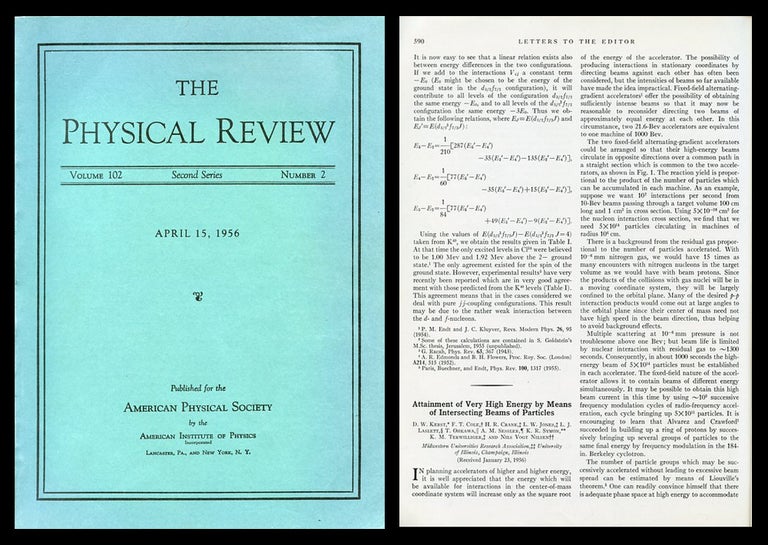Attainment of Very High Energy By Means of Intersecting Beams of Particles in Physical Review, Vol. 102, No. 2, 1956, pp. 590-591
Lancaster: American Institute of Physics, 1956. 1st Edition. FIRST EDITION IN ORIGINAL WRAPS IN WHICH KERST REINVENTS COLLIDING BEAMS AS A METHOD OF REACHING HIGHER ENERGY & HERE PRESENTS “THE FIRST SERIOUS PROPOSAL FOR A COLLIDER” (WIKIPEDIA). Kerst proposed “a method for doubling the energy of impacts in particle accelerators by accelerating two beams of particles in opposite directions before allowing them to collide. The technique, [now] called “beam stacking”, is currently used in most modern accelerators (including LHC) to accelerate beams of particles in opposite directions so they can collide.
In the 1950s, many thought it “not possible to control two beams of particles circulating in opposite directions (LHC). Some “had thought of colliding beams as a way to avoid dissipating a large fraction of the energy in forward motion when a fixed target is struck by an accelerated particle… [but] the density of particles in a beam used as a target is too small by many orders of magnitude to produce collisions at a useful rate. (Hyder, High-Brightness Accelerators, 28).
The physicist Donald W. Kerst working at a Midwestern Universities Research Association (MURA) began to study the problem. As he and his team tried to build up a beam sufficiently intense to create a realistic collider (a type of particle accelerator involving directed beams of particles). They were trying to ascertain how they could manipulate the radio frequencies so that they could build up an intense beam yet not destroy the stacked beam at high energy? Were that issue solved, Kerst et al., could begin to study the non-linear behavior — in other words, if they could make stacked beams stand, how long would they remain standing.
As Kerst writes in this paper “In planning accelerators of higher and higher energy, it is well appreciated that the energy which will be available for interactions in the center-of-mass coordinate system will increase only as the square-root of the energy of the accelerator. The possibility of producing interactions in stationary coordinates by directing beams against each other has often been considered, but the intensities of beams so far available have made the idea impractical. Fixed-field alternating gradient accelerators offer the possibility of obtaining sufficiently intense beam so that it may now be reasonable to reconsider directing two beams of approximately equal energy at each other” (Kerst, et al., 590).
Kerst’s work, put forth in this paper, shows that beam stacking can produce a useful circulating particle density; that sufficient beam concentration can be achieved by ‘stacking’ a number of high-intensity pulses in a ring. Kerst’s proposed “storage ring colliders use this technique to accelerate particles rotating in opposite directions until they collide” (LHC). And he was right, they did. Again, this remains the methodology used in most particle accelerators., including the large hadron collider. Item #883
CONDITION & DETAILS: Lancaster: American Institute of Physics. Individual issue in original wraps meticulously rebacked at the spine. Complete. 4to (10.5 x 8 inches; 263 x 200mm). Bright and very clean inside and out. Near fine.
Price: $225.00

